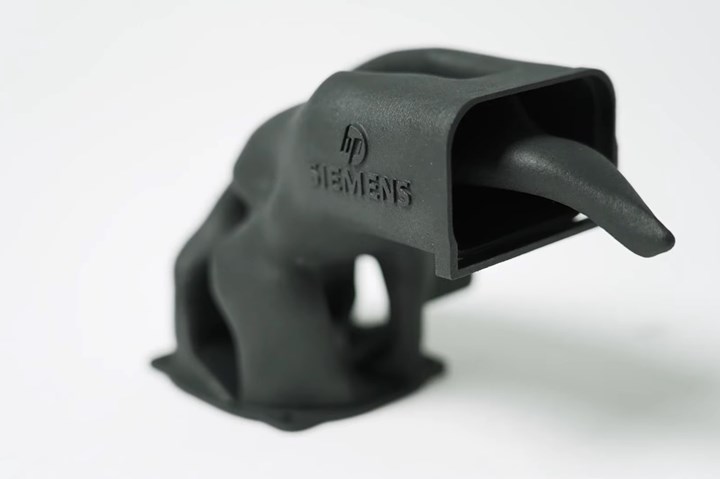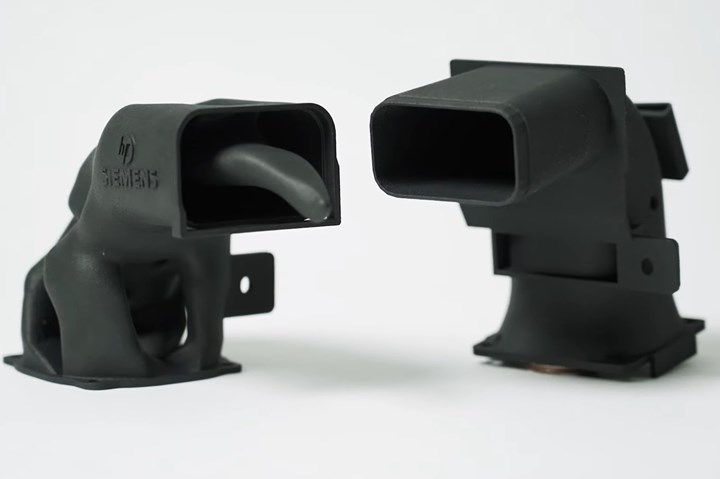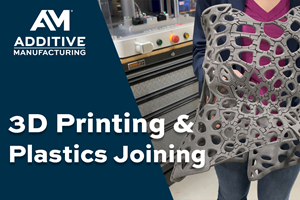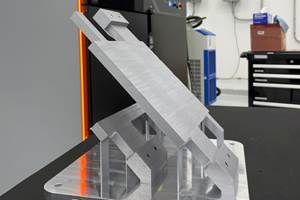Fluid Dynamics Software Optimizes Duct Airflow, Saves Energy
Siemens’ Star CCM+ fluid dynamics software enabled Siemens and HP to optimize the air flow within a 3D printed air duct for cooling HP’s Multi Jet Fusion printers.
Share
Read Next

Siemens’ Star CCM+ fluid dynamics simulation program optimized an air duct for HP’s MJF printer with a shape that most humans would be unlikely to create. Even the “tongue” serves a purpose, forcing air out of the central region of the duct.
The invisible flow of air through ducts makes it simple to forget about — and even more difficult to successfully improve upon. Siemens and HP did just that, however, with a project that optimized the air flow through a duct in HP’s Multi Jet Fusion (MJF) 3D printers. The part the two companies targeted was only a piece of a larger system, but the 22.3% efficiency boost in that part alone provided discernable improvements to the cooling of the printer.
Organic Optimization
Siemens used its Star CCM+ fluid dynamics software to develop the enhanced duct. This specialized form of topology optimization software focused on the flow of fluid through the duct’s volume, taking the original volume then condensing and eliminating material where it proved unnecessary — that is, anywhere that the flow encountered enough resistance to cause recirculation. As Ashley Eckhoff, marketing manager for Siemens’ additive manufacturing (AM) engineering group, puts it, testing the air flow is like “dropping a leaf in a stream — sometimes it’s going to rocket down that stream if it’s in the right path, and it’s going to go really fast. Other times, it may get swallowed up in the vortex over on the side somewhere, and it’s those vortexes that we want to get rid of.”

We featured this part on episode 26 of The Cool Parts Show, with hosts (and editors) Peter Zelinski and Stephanie Hendrixson discussing it at length with Ashley Eckhoff of Siemens and Luis Baldez of HP. As shown in this screencap, the build nest of the MJF printers HP used for this part can fit up to 26 air ducts.
The resulting shape was an organic form far from the original human-made design, but it consisted of only the optimal path and the interior volume of the duct. HP and Siemens still needed to perform some design work on the rest of the part (connecting the duct to the rest of the assembly, for example) to make the software’s idealized form a physical reality. However, even with the additional design work, Siemens’ fluid dynamics software pared the design time down from four months to a single month. The 3D printed design also provided assembly consolidation, combining six different injection molded parts into one part and eliminating both the molding tools and the assembly steps.
For the actual printing of the parts, the companies naturally or ironically decided to print this duct for HP’s MJF printers on MJF printers. Multi Jet Fusion is a production polymer 3D printing process with a powder bed that involves rapid melting and rapid cooling to solidify the part layer by layer. Users can nest a variety of parts within the three-dimensional build volume; the air duct was made in batches of 26 parts per build.

Optimization through fluid dynamics not only resulted in a 22.3% efficiency gain over the human-designed part, but shortened the process of designing the part (left) from start to finish to four weeks. By comparison, the original part (right) took four months to design.
Wide-Reaching ROI
The usual cost benefits of AM — such as being able to alter part designs without constructing new tooling — apply here, alongside part-specific benefits like now being able to swap less-expensive, lower-powered fans for the same output within the printer. Meanwhile, because this optimization focused on one part, HP and Siemens did not need to worry about justifying AM’s material or printing costs throughout the system. They were able to reap the benefits of fluid dynamic optimizations while making use of traditional manufacturing where it made fiscal sense.
The potential for fluid dynamics and generative design in additive manufacturing is wide-reaching. While the software’s use for vacuums, fan systems and the ductwork of any vehicle is obvious, MJF’s ability to print fluid-type material can take this optimization to unexpected places — such as cooling in battery packs. But no matter the application, the MJF printers will be able to spend less power on cooling during the printing process because of the optimized airflow through the cooling duct.
Related Content
Concept Sneaker Boasts One-Piece 3D Printed TPU Construction
The Reebok x Botter Concept Sneaker Engineered by HP premiered at Paris Fashion Week, hinting at manufacturing possibilities for the future of footwear.
Read MoreAt General Atomics, Do Unmanned Aerial Systems Reveal the Future of Aircraft Manufacturing?
The maker of the Predator and SkyGuardian remote aircraft can implement additive manufacturing more rapidly and widely than the makers of other types of planes. The role of 3D printing in current and future UAS components hints at how far AM can go to save cost and time in aircraft production and design.
Read MoreVideo: 3D Printing Paired with Plastics Joining
Conventional 3D printing wisdom is to combine as many components as possible into one 3D printed piece. Plastics joining technology expert Extol illustrates the benefits that come from printing in many pieces instead.
Read MoreWhat Does AM Want? Here Are 4 Aims (Maybe 5) That Additive Manufacturing Is Driving Toward
Certain freedoms and contributing factors allow additive manufacturing to realize its full promise for production.
Read MoreRead Next
4 Ways the Education and Training Challenge Is Different for Additive Manufacturing
The advance of additive manufacturing means we need more professionals educated in AM technology.
Read MoreHybrid Additive Manufacturing Machine Tools Continue to Make Gains (Includes Video)
The hybrid machine tool is an idea that continues to advance. Two important developments of recent years expand the possibilities for this platform.
Read MoreAt General Atomics, Do Unmanned Aerial Systems Reveal the Future of Aircraft Manufacturing?
The maker of the Predator and SkyGuardian remote aircraft can implement additive manufacturing more rapidly and widely than the makers of other types of planes. The role of 3D printing in current and future UAS components hints at how far AM can go to save cost and time in aircraft production and design.
Read More





















